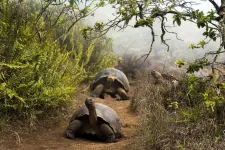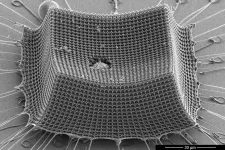(Press-News.org) COLUMBUS, Ohio - Flavor is the name of the game for scientists who want to optimize food for consumption in ways that improve nutrition or combat obesity.
But there is more to flavor than the substances that meet the mouth. Olfaction, our sense of smell, is a major contributor to how we perceive aromas, especially those related to what we eat.
With hopes to capitalize on the smell factor in flavor development, researchers are exploring how the route an aroma takes to get to the olfactory system, through the nose or the back of the throat, influences our response to the scent in question.
In a new study, when participants were asked to match a known scent such as rose with one of four unknown scents, they did best when the aromas were introduced in the same way, either through sniffing them in a vial or drinking them in a solution - an expected result.
The scientists were surprised to find, however, that participants were also better at matching aromas when the reference scent - the one that they were going to try to find a match for - was not labeled with its familiar name. The less they knew about the reference aroma, the higher their chances of correctly identifying a match - a finding that suggests aroma detection involves learning, memory and cognitive strategy.
The team eventually wants to consider other factors that could influence the perception of aromas and flavors, such as genetics and our microbiomes, the communities of microbes living in our nasal passages and oral cavities.
"A better understanding of these mechanisms could give us another way to modulate flavors and to modulate food-related experiences," said Christopher Simons, associate professor of food science and technology at The Ohio State University and senior author of the study. "It's really hard to understand what people experience, and I don't have access to your brain to see exactly what you're perceiving. But if there are ways to influence that perception, maybe that's a way to get people to eat healthier."
The study is published in the September 2021 issue of the journal Physiology and Behavior.
Simons and colleagues were testing the theory known as the "duality of smell," which posits that how we perceive what we're smelling depends on which path it takes to get to the olfactory system.
The theory has been supported by tests of food flavors that we're used to putting in our mouths. In this study, the researchers used less familiar floral scents - which study participants drank in a solution to activate the sense of smell through the back of the throat and sniffed from a vial to activate the sense of smell through the nose.
The 34 participants would first either sniff or drink the reference scent, which was labeled with its common name - the choices were rose, lavender, honeysuckle or jasmine - its Latin name, or a generic label that gave no information. They then sampled the same unnamed four floral scents - either through the same sense-of-smell pathway or its opposite - with the goal of finding the match to the reference aroma.
When the routes of delivery differed, participants made more mistakes, meaning there was something about those delivery systems to the nose that altered their ability to recognize similar scents - further supporting the duality of smell hypothesis.
But the finding that no information was better than a clear scent name was unexpected - and also suggests that this is where cognitive activity comes into play.
"If I say 'rose,' there's information that will affect the way you process and smell those aromas. When there's no identifying information, what you have to do is profile - smell it and find something distinguishing about that particular aroma. That's much harder than knowing what you're looking for," Simons said.
"We think there's cognitive interference from the language centers that impacts how people do this matching and searching test. ... Fundamentally, the fact you have exactly the same stimulus that activates exactly the same receptors, and you can't make a match - that's fascinating."
Simons is interested in repeating this kind of test with unpleasant aromas to see if the theory holds up, and also hopes to conduct experiments that could reveal whether our genetic makeup or the array of microbes and enzymes in our noses and mouths hold secrets to why the duality of smell exists in the first place.
INFORMATION:
This work was supported by state and federal funds appropriated to Ohio State's Ohio Agricultural Research and Development Center. Co-authors Mackenzie Hannum and Jenna Fryer were students in Simons' lab.
Contact: Christopher Simons, Simons.103@osu.edu
Written by Emily Caldwell, Caldwell.151@osu.edu
Champaign, IL, July 19, 2021 - For dairy cows, the transition period--the time between a cow giving birth and beginning to produce milk--brings the greatest possibility of health problems. The current widespread belief is that the effects of excess nonesterified fatty acids (NEFA) in the bloodstream and the ensuing hyperketonemia during this period, coupled with low levels of available calcium, are largely responsible for disorders such as mastitis, metritis, retained placenta, and poor fertility. Much attention has therefore been devoted to regulating NEFA and calcium levels in transition cows--yet all these efforts have not made the transition period less of a challenge to cows and, hence, to farmers, with approximately ...
The second dose of a COVID-19 vaccine induces a powerful boost to a part of the immune system that provides broad antiviral protection, according to a study led by investigators at the Stanford University School of Medicine.
The finding strongly supports the view that the second shot should not be skipped.
"Despite their outstanding efficacy, little is known about how exactly RNA vaccines work," said Bali Pulendran, PhD, professor of pathology and of microbiology and immunology. "So we probed the immune response induced by one of them in exquisite detail."
The study, ...
The MOMAT research group from Universidad Complutense de Madrid has worked with Universidad de Almería, to develop a mathematical model that simulates the impact of SARS-CoV-2 strains and vaccines together, combined with many other biological and social processes in the propagation of COVID-19.
The tool can be downloaded without restriction and free of charge and applied to any territory. It forms part of the family of θ-SIR models, which were initially developed by the MOMAT research group itself before the arrival of new variants and the development of vaccines.
"The model allows us to estimate for the first time ...
UCC-UCM, 13 July. The Giant Galapagos tortoises which live in contact with human farming and tourism activities, or in urbanised zones, have more bacterial resistance to antibiotics than those that live in more isolated ecosystems.
This is the main conclusion of the research published in Environmental Pollution on which Universidad Complutense de Madrid participated together with the Charles Darwin Foundation (FCD), the Institute for Conservation Medicine of the Saint Louis Zoo (ICM), the Centre for Animal Health Research (INIA-CISA) and Universidad Europea de Madrid.
Ainoa Nieto, the lead author, researcher at ICM/FCD and collaborator ...
Analysis of children and young people's proximity to woodlands has shown links with better cognitive development and a lower risk of emotional and behavioural problems, in research led by UCL and Imperial College London scientists that could influence planning decisions in urban areas.
In what is believed to be one of the largest studies of its kind, researchers used longitudinal data relating to 3,568 children and teenagers, aged nine to 15 years, from 31 schools across London. This period is a key time in the development of adolescents' thinking, reasoning and understanding of the world.
The study, published in Nature Sustainability, looked at the links between different types of natural urban environments and ...
When it comes to transitioning from carbon-based to renewable source energy systems, Americans are on board. They're less keen, however, having these new energy infrastructures--wind turbines or solar farms--built close to their homes, which creates hurdles for policymakers. That's according to a study from University of Georgia researcher Thomas Lawrence.
Lawrence and an international team conducted surveys in the United States, Germany and Ireland to assess people's attitudes about renewable energy technologies and their willingness to have the necessary infrastructures built nearby.
"People in Germany and Ireland were more open to having renewable ...
A serendipitous flythrough of the tail of a disintegrated comet has offered scientists a unique opportunity to study these remarkable structures, in new research presented today at the National Astronomy Meeting 2021.
Comet ATLAS fragmented just before its closest approach to the Sun last year, leaving its former tail trailing through space in the form of wispy clouds of dust and charged particles. The disintegration was observed by the Hubble Space Telescope in April 2020, but more recently the ESA spacecraft Solar Orbiter has flown close to the tail remnants in the course of its ongoing mission.
This lucky ...
RESEARCH TRIANGLE PARK, N.C. -- Army-funded research identified a new material that may lead to lightweight armor, protective coatings, blast shields and other impact-resistant structures.
Researchers at the U.S. Army's Institute for Soldier Nanotechnologies at the Massachusetts Institute of Technology, Caltech and ETH Zürich found that materials formed from precisely patterned nanoscale trusses are tougher than Kevlar and steel.
In experiments, the ultralight structures, called nanoarchitectured materials, absorbed the impact of microscopic projectiles accelerated to supersonic speeds.
"Increasing protection while simultaneously decreasing the weight that ...
It's no secret that studies show that sexually diverse youth - in particular, lesbian, gay and bisexual (LGB) youth - use more cannabis and experience more mental health challenges than their heterosexual peers.
But what about the changes that occur in the rates of cannabis use: do they precede those related to mental health or is it the other way around? A new study from Université de Montréal offers some answers.
In the Journal of Abnormal Psychology, Kira London-Nadeau, a doctoral student and CIHR Vanier Scholar in the Department of Psychology at UdeM and the CHU Sainte-Justine Research ...
Germany is not meeting its legal obligations to protect refugee women and girls from discrimination. This is the conclusion of a "shadow report" by the University of Göttingen, the association Pro Asyl and the refugee councils of Bavaria, Hesse, Lower Saxony and Saxony-Anhalt. Shadow reports are a useful tool to present important information in parallel with official government reports. Based on current research results and a survey of 65 women's counselling centres, psychosocial counselling centres and institutions working with refugees from all 16 federal states, the study finds that Germany does not adequately protect refugee women and girls and does not meet the requirements of the Istanbul Convention.
"The Istanbul Convention - also known as the Council of Europe convention ...




